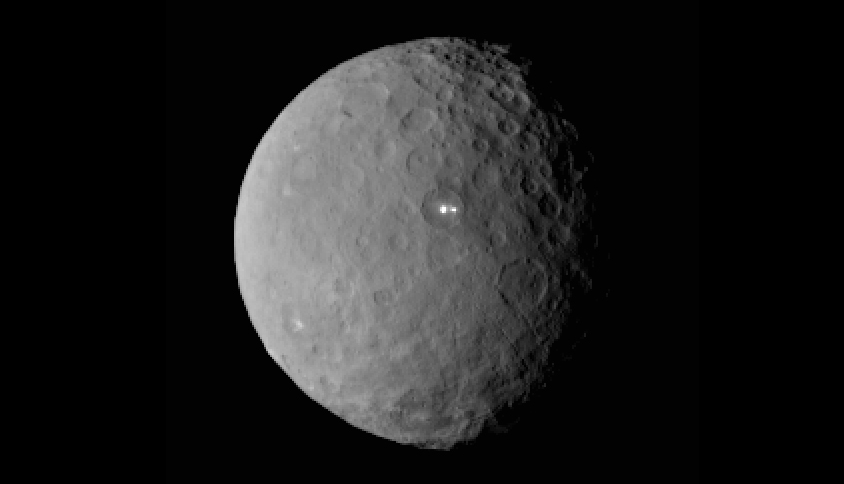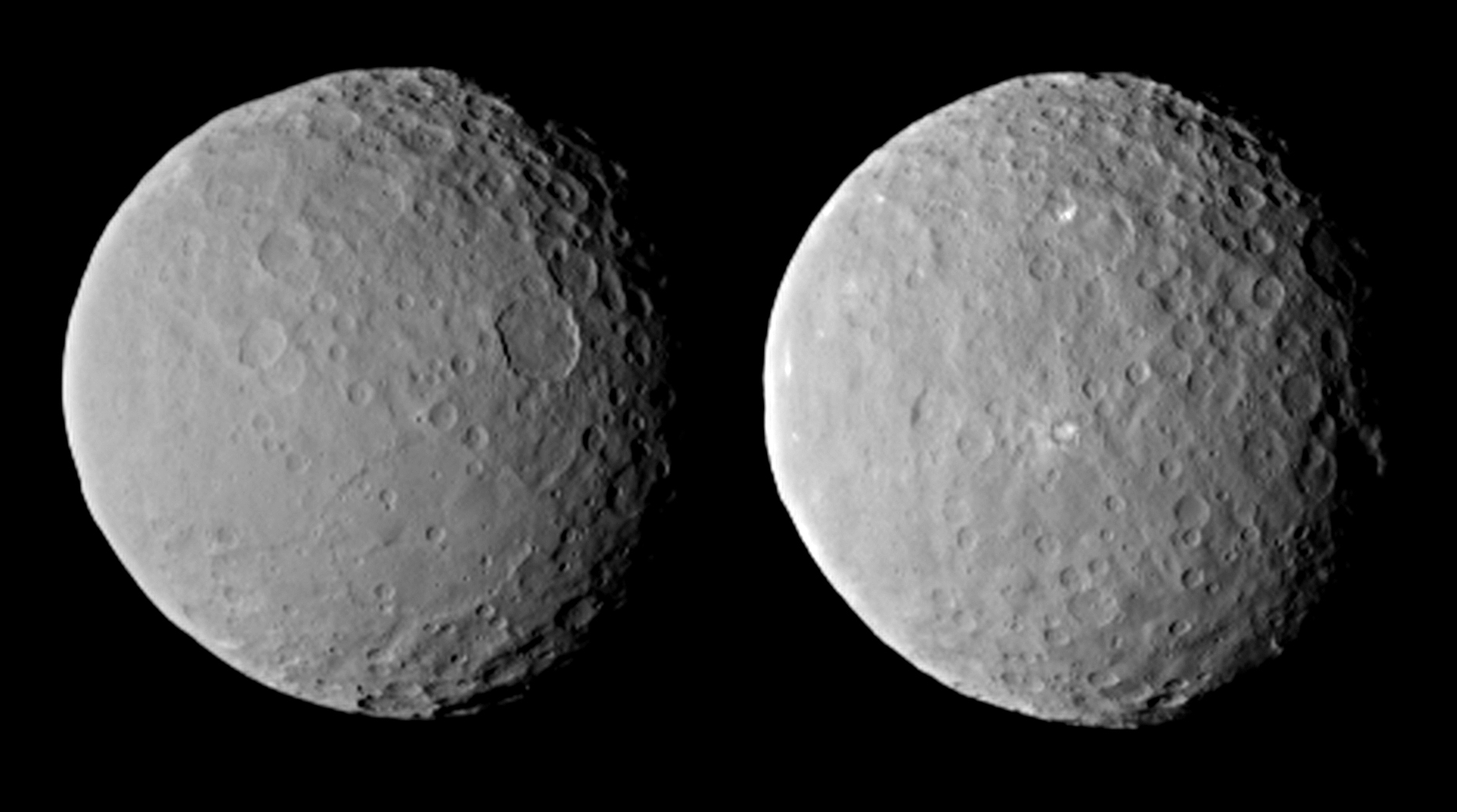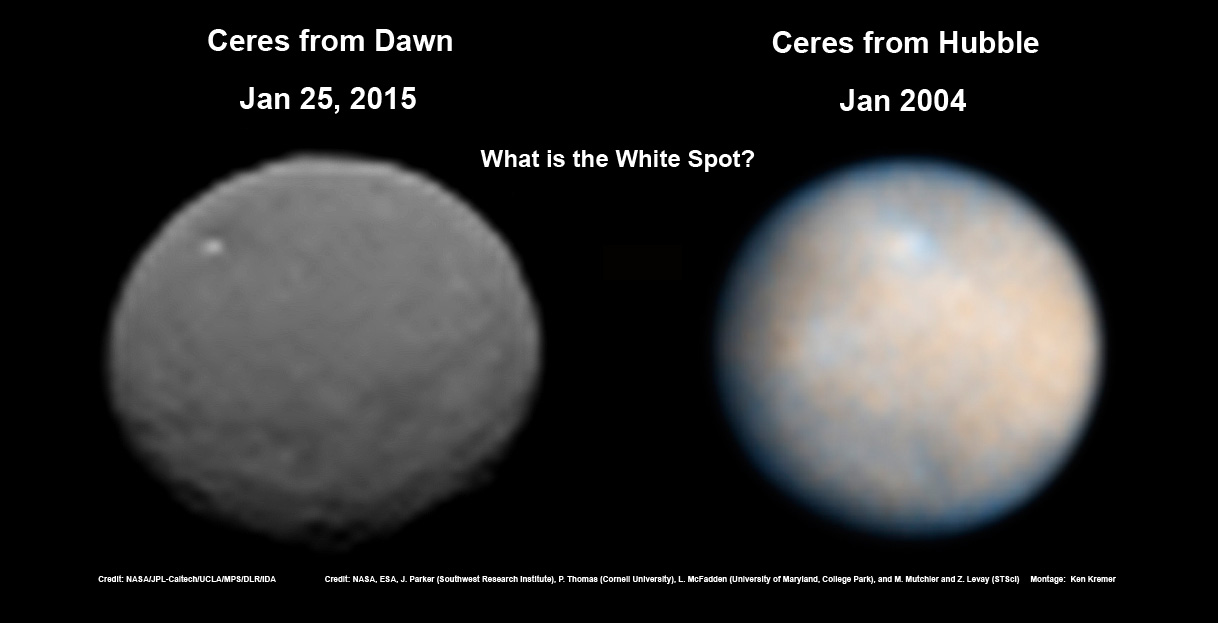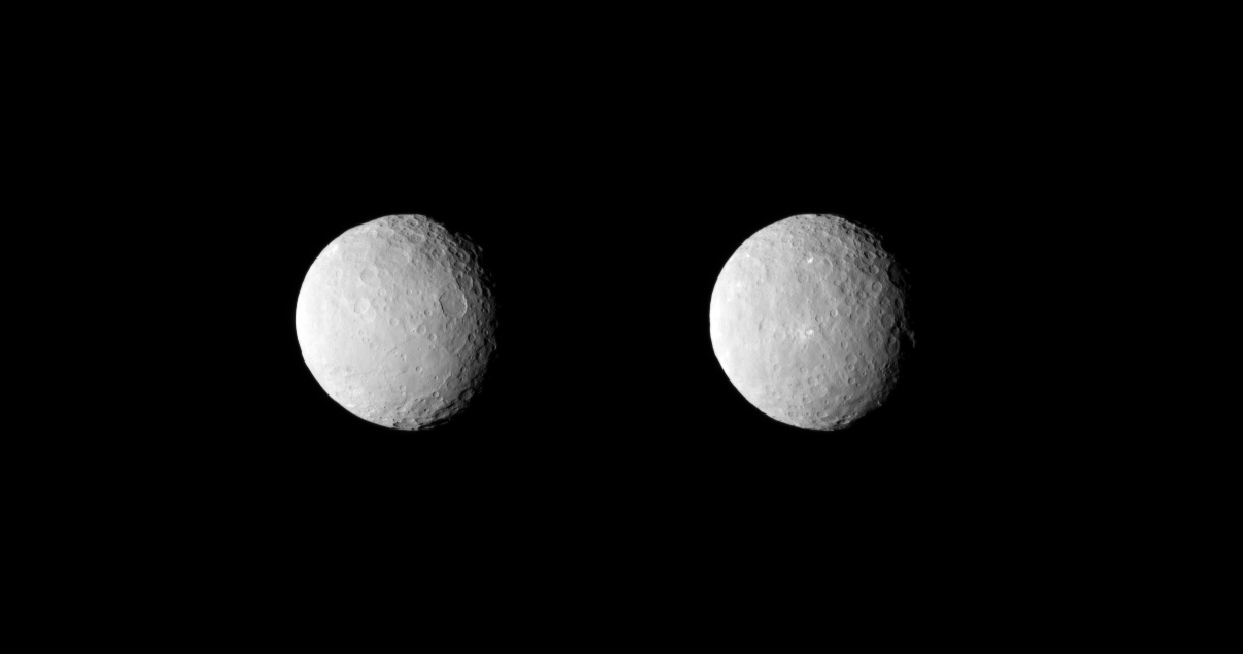
A scientific mystery on dwarf planet Ceres—worthy of investigation by 21st century scientists and Star Trek’s 23rd century Science Officer Mr. Spock—is deepening, even as the Dawn spacecraft journeys ever closer to orbital capture one week from today!
Leonard Nimoy, who portrayed the character Mr. Spock aboard the fictional Starship USS Enterprise on TV and film, passed away today, Feb. 27, at age 83. He was a friend of Dawn and NASA.
Spock, of the planet Vulcan, who was famous for the satanic-like look emanating from his pair of pointy ears and high-browed eyes, would surely have relished investigating the mystery of the “Bright spots on Ceres,” which grows ever more puzzling as the newest images from NASA’s Dawn reveal an unfathomable duo of adjacent bright white spots that look like a pair of “fascinating” eyes.
The newest images from Dawn were taken by the probe’s camera on Feb. 19 and remarkably show that the brightest spot visible on Ceres’ surface is actually two bright spots, lying adjacent to one another. They are located inside a huge basin and are eerily peering out from the pockmarked surface like a pair of alien eyes.
The second eye is just a bit dimmer than the first.
The new images were captured by the framing camera at a distance of 29,000 miles (46,000 kilometers) from Ceres. They were released by NASA on Feb. 25 and are shown above and below.
“Ceres’ bright spot can now be seen to have a companion of lesser brightness, but apparently in the same basin,” said Chris Russell, principal investigator for the Dawn mission, of the University of California, Los Angeles, in a statement.
“This may be pointing to a volcano-like origin of the spots, but we will have to wait for better resolution before we can make such geologic interpretations.”
The nature of the eyes of Ceres remain a mystery because they are still too small to be resolved by Dawn’s cameras.
“They are a source of frustration for us because we cannot determine what they are yet,” Russell told AmericaSpace.
“The resolution is still too course to examine their structure which could lead us to understand their source.”
Ceres may harbor an ocean of subsurface liquid water, as large in volume as the oceans of Earth, below a thick icy mantle, despite its small size—and thus could be a potential abode for life.

“The brightest spot continues to be too small to resolve with our camera, but despite its size it is brighter than anything else on Ceres. This is truly unexpected and still a mystery to us,” said Andreas Nathues, lead investigator for the framing camera team at the Max Planck Institute for Solar System Research, Gottingen, Germany.
Dawn will photograph Ceres in high resolution and determine its mineralogy and chemical composition with a trio of instruments as part of an international science mission with partners in the U.S., Germany, and Italy.
Nimoy was a “friend of NASA” who inspired countless people (including this author) to become scientists, engineers, and space explorers, as NASA Administrator Charles Bolden said in a statement today:
“Leonard Nimoy was an inspiration to multiple generations of engineers, scientists, astronauts, and other space explorers. As Mr. Spock, he made science and technology important to the story, while never failing to show, by example, that it is the people around us who matter most. NASA was fortunate to have him as a friend and a colleague. He was much more than the Science Officer for the USS Enterprise. Leonard was a talented actor, director, philanthropist, and a gracious man dedicated to art in many forms. Our thoughts and prayers are with his family, friends, and the legions of Star Trek fans around the world.”
Leonard Nimoy narrated this 2007 video explaining the goals of the Dawn mission, with the mission scientists and engineers, which is powered by Star Trek-like ion propulsion technology:
Video Caption Published on Feb 27, 2015: Produced in 2007, this overview video about NASA’s Dawn mission to giant asteroid Vesta and dwarf planet Ceres was released before the spacecraft’s launch that year. The mission greatly appreciated Leonard Nimoy’s support and participation. Dawn investigated Vesta in 2011-2012, and will arrive at Ceres March 6, 2015. Credit: NASA/JPL
It’s fitting, as Dawn closes in for capture in Ceres’ orbit on March 6, to commemorate Nimoy’s passing on the cusp of its arrival after more than seven years of interplanetary travel—made possible by the revolutionary ion propulsion system that was a key element of the fictional Star Trek universe that inspired the Dawn team.
Here’s how Leonard Nimoy/Mr. Spock, of Starship Enterprise, and Chief Engineer Dr. Marc Rayman, of JPL, described Dawn:
“To accomplish Dawn’s journey into the heart of the asteroid belt, a space ship, one whose engine will work without fail for years at a time, is required. Dawn’s remarkable ion engines employ electrical currents, magnetic fields and xenon. The high tech innards of an ion engine change the xenon into a positively-charged plasma and accelerate it out the engine at speeds over 78-thousand miles per hour,” said Nimoy.
“The ion engine pushes on the spacecraft about as hard as this single piece of paper pushes on my hand. But this very gentle thrust eventually builds up and allows the spacecraft to achieve very, very high speed. With the ion propulsion system, Dawn will be the first spacecraft ever to orbit two target bodies after leaving Earth,” said Rayman.
“A mission into our distant past, a mission for the future, a mission into the heart of the asteroid belt, a mission called Dawn,” concludes Nimoy.

Dawn is the first spacecraft from Earth to visit Ceres and is on course to be captured into orbit on March 6 as it continues its relatively slow approach.
After achieving orbit, Dawn slowly spirals in and reaches its initial science altitude orbit of about 8,400 miles (13,500 kilometers) in mid-April.
The new photos from Feb. 19 are the best yet and are part of a series taken as Dawn observed Ceres completing one full rotation, which lasted about nine hours.
“Ceres is a survivor from the earliest days of the Solar System and is an example of the first bodies that formed in the solar system and that eventually came together to build the Earth and other planets,” Russell said.
“Ceres is just a ‘young planet’ even though it was formed 4.6 billion years ago!”
It will soon make history as the first spacecraft to orbit two celestial bodies beyond Earth.
Dawn first visited Vesta, the second most massive asteroid in the main belt, for a year in 2011 and 2012.
Ceres measures about the size of Texas, with a diameter of approximately 590 miles (950 kilometers). It is the largest and most massive object in the main Asteroid Belt, which lies between Mars and Jupiter.
But we know next to nothing about the diminutive world.
As Ceres rotates it reveals a pockmarked world, heavily crated and featuring multiple bright “white spots” that have mystified the scientists and public alike.
Mr. Spock would “enjoy” that challenge in his unemotional way. “Fascinating.”
Live Long and Prosper.
“RIP Leonard Nimoy. So many of us at NASA were inspired by Star Trek. Boldly go,” NASA tweeted today Feb. 27, 2015.

Stay tuned here for continuing Dawn updates!
Want to keep up-to-date with all things space? Be sure to “Like” AmericaSpace on Facebook and follow us on Twitter: @AmericaSpace





More outstanding work from JPL!
Thank your for this, your last science report Mr. Spock.